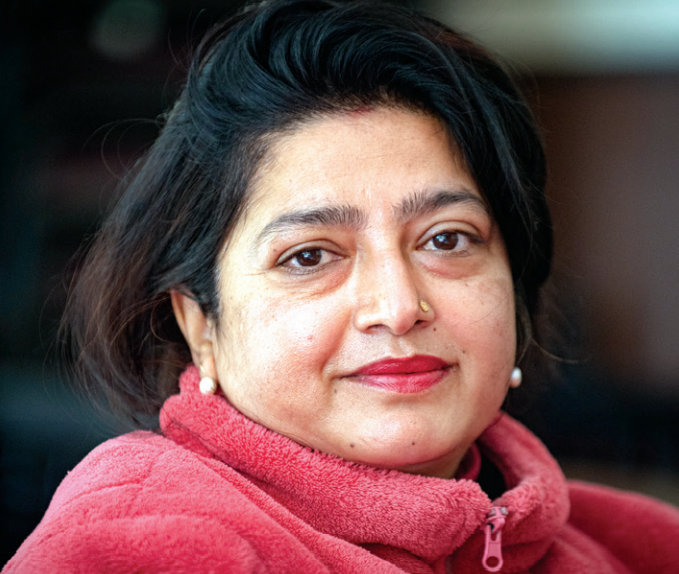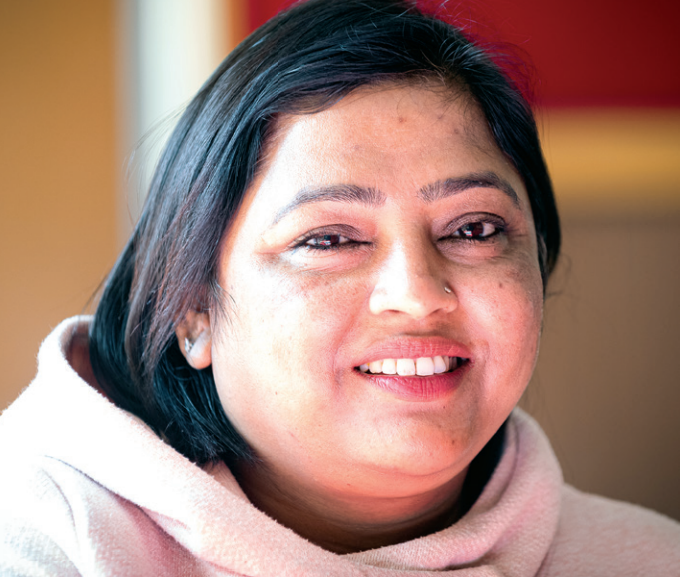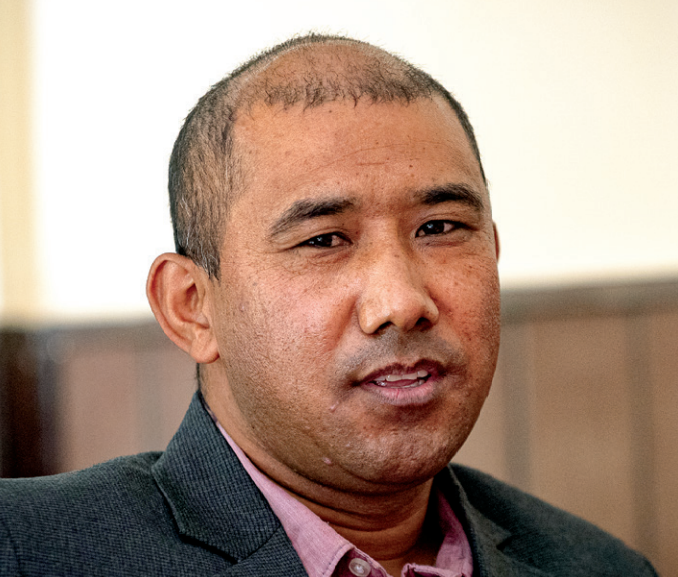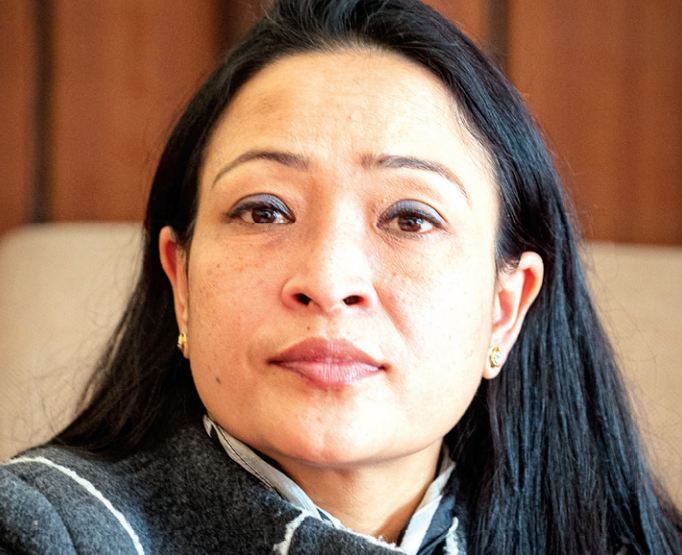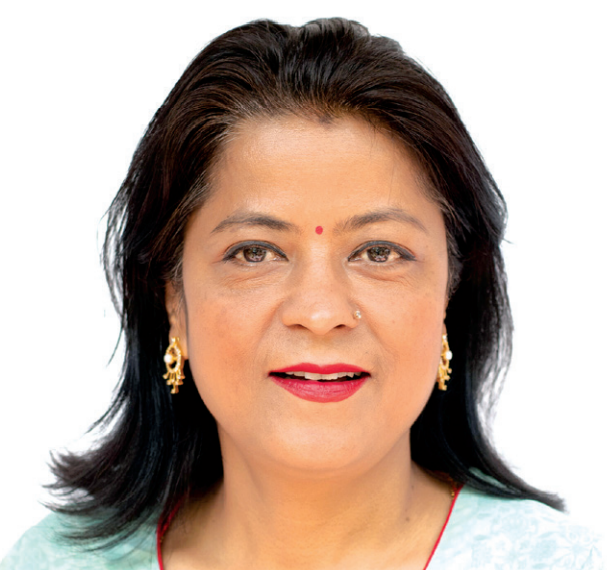Radheshyam Adhikari: Far too early to discard the National Assembly
The Election Commission recently elected 19 National Assembly members. In this connection, Pratik Ghimire of ApEx talked to Radheshyam Adhikari, outgoing National Assembly member of Nepali Congress, on the assembly’s shortcomings and achievements over the past four years.
What are the major duties of the National Assembly?
Besides formulating and passing bills, the National Assembly oversees and instructs the works of the government. It also discusses and sends resolution proposals on national issues, projects of national pride, and issues of public interest. Besides, the assembly examines the delegated powers of universities and other delegated legislative bodies.
How do you evaluate the past four years of the National Assembly?
The assembly could certainly have performed better. As we have diverse duties, there may have been some shortcomings. But that doesn’t mean we didn’t perform at all. We updated and offered suggestions on many important bills to the lower house. For example, the draft of the Passport Bill sent by the lower house was so regressive that all the power was centered on the government. It was the upper house that made sure that the bill would be universal and accessible to all and updated it accordingly. We also revised the bill to amend the Citizenship Act and the Nepal Special Service Bill on counterintelligence, among others. The controversy surrounding the Guthi Bill was also resolved after the assembly revised its draft.
So why is the assembly repeatedly accused of underperformance?
There are fewer sessions of the National Assembly, say compared to the House of Representatives sessions. Our sessions are only called when the lower house is active and it has kept us in the shadows. The conflict among the political parties in the lower house has hamstrung the performance of the upper house as well.
Do we really need the National Assembly? Isn’t the House of Representatives enough?
It is too soon to debate that. Everything has its time and the National Assembly must be given enough time to perform. If the assembly could not perform as expected, say after the next two elections of the lower house, then this debate could be relevant. For now, we should debate how to bring deserving members to the assembly and work effectively.
We also need the National Assembly to honor the spirit of check and balance. As I mentioned earlier, the upper house has done a lot of work on important bills. The lower house has a tendency of working in a rush. It always forwards bills that are incomplete and full of ambiguities. It is the work of the upper house to address those issues.
Has the National Assembly become a platform for parties to accommodate leaders who fail to get into the lower house?
I don’t think that is the case. There are many deserving leaders who have made decent contributions to bring political changes in Nepal since the 1990s, and they have not gotten the chance to serve the nation. So bringing them into the National Assembly is only fair. But I do believe that the assembly is a chamber of intellectuals and experts, and that its members must have required skills and qualifications.
Representation at the local level
As per the suggestion of the ruling coalition, the government and the Election Commission have tentatively agreed to hold local elections in one phase on May 18.
The major political parties have already started preparing. But there could be plenty of political drama before the election-day. Speculations are already rife about election outcomes and positions of major parties.
In the past five years, there has been a lot of turbulence inside major parties. In 2018, the CPN-UML and the CPN (Maoist Center) united to form the Nepal Communist Party (NCP), but the Supreme Court in March 2021 voided the merger and revived the old parties. Madhav Kumar Nepal then went on to split the UML to form CPN (Unified Socialist), becoming the fourth largest parliamentary party.
Maoist chairman Pushpa Kamal Dahal ‘Prachanda’ and CPN (Unified Socialist) leader Nepal have made it clear that they want a continuity of the ruling coalition under Nepali Congress until the elections. However, there is a strong voice within Congress that it should not ally with any of the leftist parties. The UML, meanwhile, wants to break the coalition and isolate Congress in order to retain the position of the largest party.
“As the parties have no new political agenda, the only way to win more seats is by cutting the votes of rival parties. So the smaller parties could play a vital role by splitting votes,” says Bishnu Dahal, a political analyst.
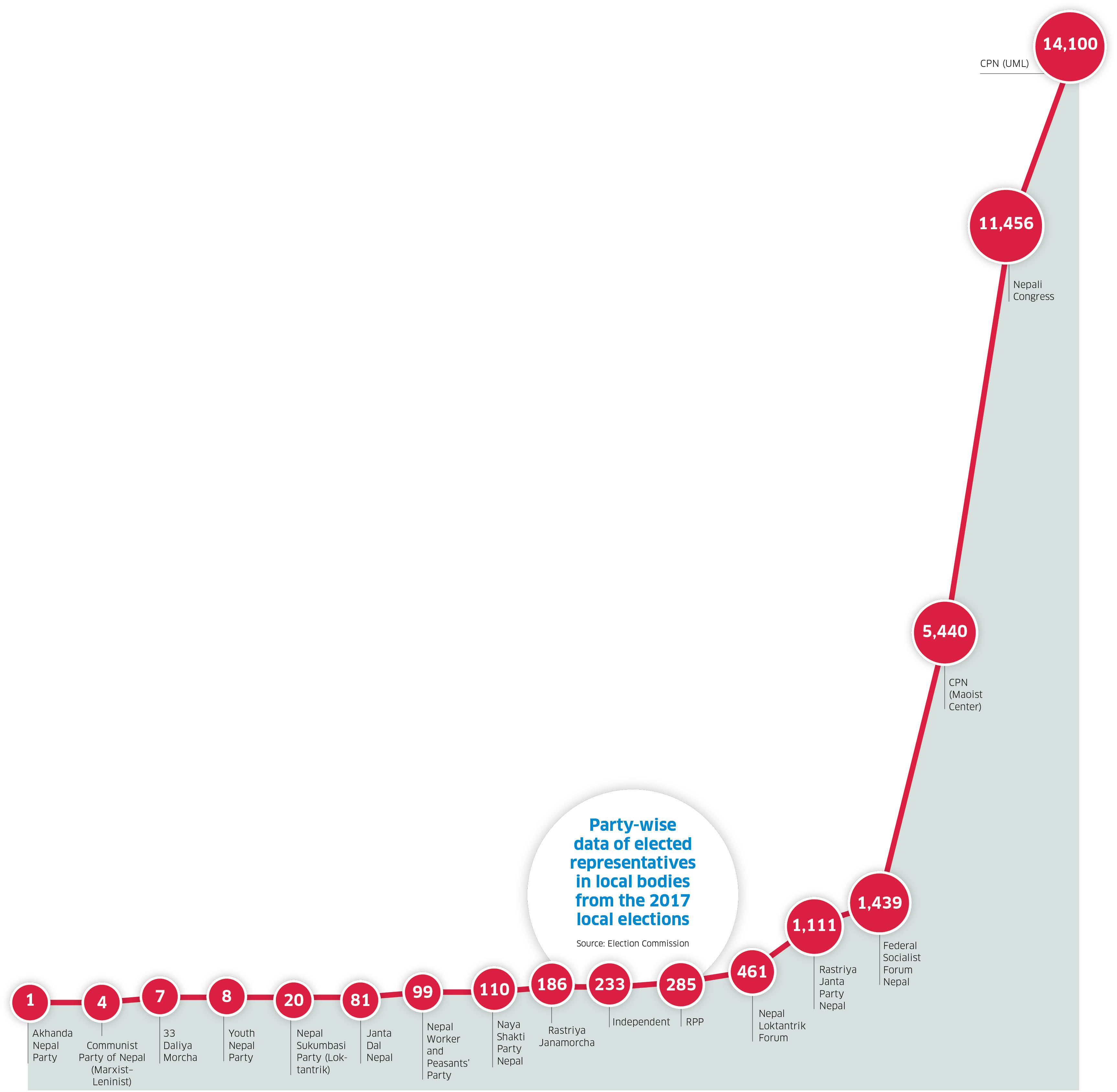
Similarly, in 2019, Baburam Bhattarai-led Naya Shakti Party and Upendra Yadav’s Federal Socialist Forum merged to form the Samajbadi Party Nepal. Then in April 2020, the party merged with the Mahanta Thakur and Rajendra Mahato-led Rastriya Janta Party Nepal to form Janta Samajbadi Party Nepal. But after little over a year of working together, the Thakur-Mahato faction broke off to form the Loktantrik Samajbadi Party Nepal. The effect of mergers and breakups in political parties is certain to reflect in poll results as well.
Bibeksheel Sajha Party remains without representation at the local level, and it plans to change that this time around. Bibeksheel Chairman Rabindra Mishra recently changed the party’s line and is now pitching for return of monarchy and referendum on Hindu state. There are rumors of Bibeksheel forming an electoral alliance with the pro-monarchy Rastriya Prajatantra Party (RPP) for local polls.
The two parties have already discussed the possibility, and the RPP’s newly elected chairman, Rajendra Lingden too seems keen on working together with like-minded forces, at least for the elections.
“This time, the parties will focus on defeating others rather than winning elections on their own strength,” Dahal says. “There is a likelihood of UML and Congress contesting alone while the remaining parties could form an electoral coalition against the Big Two, making it a three-way fight.”
Tenzing Sherpa: Nepal’s pioneering DJ
When Tenzing Sherpa got the role of the ‘music player’ in Club Jolly Blues—the first discotheque in Kathmandu—back in 1992, he didn’t know the profession was called disk jockeying. He was an ordinary music-loving teen who used to go to the club every evening to listen to music and the club owner, with whom he had developed a friendship, offered him a job. He got himself the stage name DJ Tenzing and started playing with CDs and simple mixing devices as there were no professional instruments or training in Nepal in those days.
Born and raised in Solukhumbu, Sherpa came to Kathmandu for higher studies after completing his SLC. Until then, he had no fixed aim in life. He just wanted to make enough to pay his college fees and rent. “I used to leave the club at 2 am and attend my college at 5 am,” Sherpa shares about his initial days in the profession. “I then slept after returning from college at 9 am.”
Even long after starting out on this journey, he hadn’t dreamt of a professional career as a DJ: playing music was just a hobby and a small source of pocket money. But DJs started getting space on outdoor musical concerts and festivals after 2006, which made them more sought-after and increased their earnings too, and it was only then that Sherpa chose DJ as his permanent career. By then, the Internet and other technologies had also developed, which came in handy for him to practice new styles of playing.
After seven years at Club Jolly Blues, in 1999, Sherpa joined Club X-zone at Durbar Marg. He played there for around three years. He also worked at Hyatt Regency’s Rox Bar and Hotel Yak and Yeti’s Club Platinum. He started doing freelance shows from 2008. Till date, he has done over 1,000 stage programs in and outside the country, including in the US, the UK, Korea, Japan, Israel, Germany, Belgium, France, Luxemburg, Portugal, Spain, Netherland, Hong Kong, Qatar, and India, among other countries . “There is nothing better than seeing people dance and love your remix,” he shares when asked about the best part of being a DJ.
Also read: Sugam Pokharel: The ideal Nepali pop culture Idol
In 2007, to promote his maiden album “DJ Tenzing”, he organized “DJ Tenzing All Nepal Tour” with several popular Nepali singers. The album includes various popular songs like ‘Isarale Bolaunu Pardaina’, ‘Jham Jham Istakot’, ‘Jhimkai Deu Pareli’, ‘Lalupate Fulyo Banaima’, ‘Yo Gaun Ko Thito Ma’, etc. Sherpa has also done a show at Everest Base Camp with the theme of “Stop Global Warming and Save the Himalayan”. Besides that, he was one of the judges in a DJ reality show “War of DJ” which aired for three seasons from 2010 to 2012.
“I have seen many ups and downs in the DJ fraternity during my three decades in the industry,” he says. For example, in the past, DJs didn’t have money, but they had prestige, but these days, things are exactly the opposite, Sherpa remarks. DJs are only regarded as ordinary guys with laptops and headphones, he notes. “I have groomed myself by mixing manually but youngsters nowadays just put software at auto-tune,” says Sherpa.
“I wish the government had plans to promote nightclubs as they also attract a decent number of tourists and thus contribute to the economy,” he says. Sherpa thinks that these clubs, which employ people from diverse backgrounds, have been devastated by the pandemic. But instead of helping them out in these difficult times, the government seems intent on stifling their growth, he laments.
There are many DJs in town today: half in the scene to cultivate their hobby while the other half is determined to make it a career. Sherpa sees the future of DJ aspirants as bright as the number of clubs in the country is steadily rising. “It is not that difficult to sustain financially, and if you can maintain good PR, you will get the shows and tours on a regular basis.”
Vijay Kumar Sarawagi: Birgunj is ready for the new covid wave
Open borders with India represent a major challenge in stemming the spread of coronavirus. With cases in India peaking, entry points on Nepal-India border have been put on high alert. Birgunj, the busiest Nepal-India gateway, is often regarded as Nepal’s Covid-19 hotspot. This time too, the city has seen cases steadily rise. Pratik Ghimire of ApEx talked to Vijay Kumar Sarawagi, mayor of Birgunj Metropolitan City, to know about their preparations and plans to contain the spread.
How are your preparations for the third wave?
Having fought valiantly against the two previous waves, Birgunj is ready to deal with the new wave with the help of our added manpower and resources. We have focused on Narayani Hospital where we have installed an automatic oxygen plant with the capacity to fill over 200 oxygen cylinders a day and oxygen lines have been added to over 600 beds, to be fed directly from the plant. As unvaccinated children are vulnerable, we have established a special child ward with all instant facilities.
Besides, we have added health desks at borders and increased the number of community contact tracing teams. Vaccination has also picked up in our metro.
What is the state of your isolation centers?
Our isolation centers have not been used as almost every covid infected individual is isolating in their homes. Moreover, it looks like this wave is less harmful as even those who are admitted to hospitals are being discharged within a week. We have also not allowed a single person to enter Nepal without a negative antigen test. Yet, for an emergency, we have built a 400-bed holding center, which can also be used for isolation.
Also read: Dinesh Kumar Thapaliya: Commission ready to hold local elections on April 27
There seems to be a lack of public awareness in the metropolitan city. How can you convince citizens to follow health protocols?
We admit that the virus has already spread in the community because almost 70 percent of those being tested are returning positive results. Many with mild symptoms are not even getting tested. They are rather self-isolating in their homes. We are encouraging them to test through various digital campaigns and are also planning to provide door-to-door PCR services. The District Administrative Office (DAO) has been monitoring compliance of protocols, and imposing a fine of Rs 100 on those violating the rules. We also provide masks to those who appear without them in public places.
Birgunj has vaccinated 57 percent of its eligible population, and many have even received doses from India. So, tentatively, over 80 percent of our citizens are vaccinated. As it is common to have a cold during the winter, people might ignore mild symptoms. Our metro has almost 30,000 children above 12 who are eligible for vaccines, and 20,000 of them have already been vaccinated. We are waiting for vaccines for minors under 12.
How much has the metro spent on covid crisis management?
We have allocated Rs 30 million for it but the fund has barely been spent as provincial and central governments have taken care of most expenses.
How has the coordination been with other governments and departments?
There is no problem between us and the DAO. But coordination among municipalities is lacking. For instance, as Birgunj is more developed compared to surrounding areas, people from neighboring municipalities come to Narayani Hospital, which is causing an overload. We have to manage logistics for that. With more support from provincial and federal governments as well as municipalities, we will surely be in a position to provide better services.
Local level facing an acute shortage of civil servants
With the promulgation of the new constitution in 2015, Nepal adopted a federal system with three tiers of government—federal, provincial and local—thereby restructuring the unitary state into a federation. This increased the number of government offices, leading to a surge in demand for workers. For instance, the offices and ministries of the seven federal provinces automatically increased the need for additional staff. In the new federal set-up, there are six metropolitan cities, 11 sub-metropolitan cities, 276 municipalities, 460 rural municipalities, and 6,743 wards. Civil servants are required to run these offices, besides supporting the functioning of elected representatives. Moreover, various departments have added branches so that citizens can conveniently get services.
As expected, there has been a severe staff shortage. Before the 2017 local level elections, the Ministry of Federal Affairs and General Administration, in coordination with the Public Service Commission (PSC) and other concerned authorities, had initiated homework to meet the workforce demand. Five years on, progress has been patchy. The tenure of elected local governments is ending in May 2022.
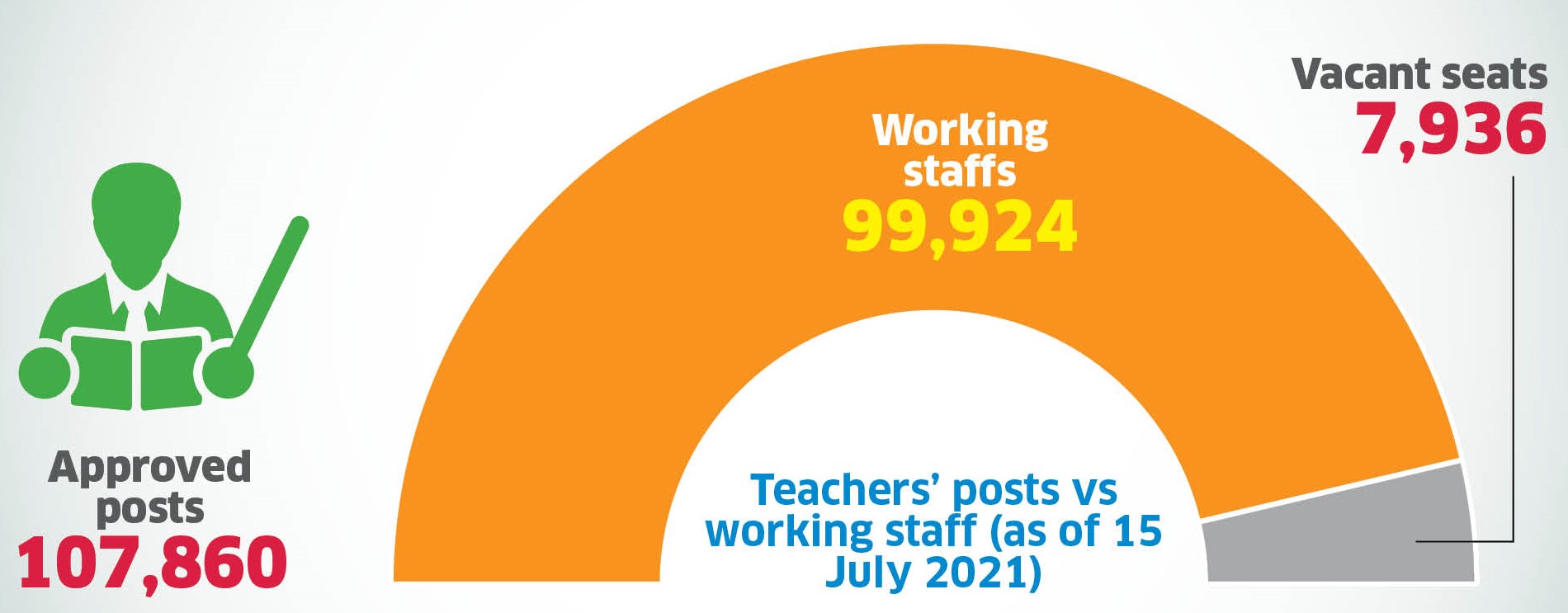
Immediately after the formation of local governments, elected representatives started complaining about the lack of civil servants. Of the almost 65,000 posts approved for the local level, more than half (i.e. 34,473) seats are still vacant. The recruitment process was moving ahead smoothly, but the ministry’s attempt for adjustment of civil employees resulted in shortage of staff in almost every local level office, hindering service delivery.
A related problem is lack of laws mandating coordination and cooperation between the federal and provincial governments. The federal government is still reluctant to delegate power to the provinces, preventing them from recruiting the required staff on their own.
Also read: Nepali political parties far from inclusive
Even though there could be no smooth adjustment of civil servants, the Nepal Police claims to have more or less adjusted its personnel in the federal and provincial governments. Right now there are 4,000 vacancies in Nepal Police but that is normal, says SSP Bishnu Kumar KC, Spokesperson and Information Officer of Nepal Police. At the end of each year, they prepare a list of approved posts and incumbent staff and coordinate with the Ministry of Home Affairs and Public Service Commission on new recruitment. Throughout the year the number of staff decreases due to resignation, retirement, and deaths. “We have deputed extra personnel in Province no. 1 and Sudurpaschim, and slightly reduced personnel in other provinces,” he adds.
Almost 8,000 seats of teachers are vacant, currently filled with temporary teachers appointed on contract basis. Temporary hiring has given rise to nepotism, favoritism and corruption, as school heads have the authority to utilize and manage school’s resources and manpower.
We need more technical civil servants
Kashiraj Dahal
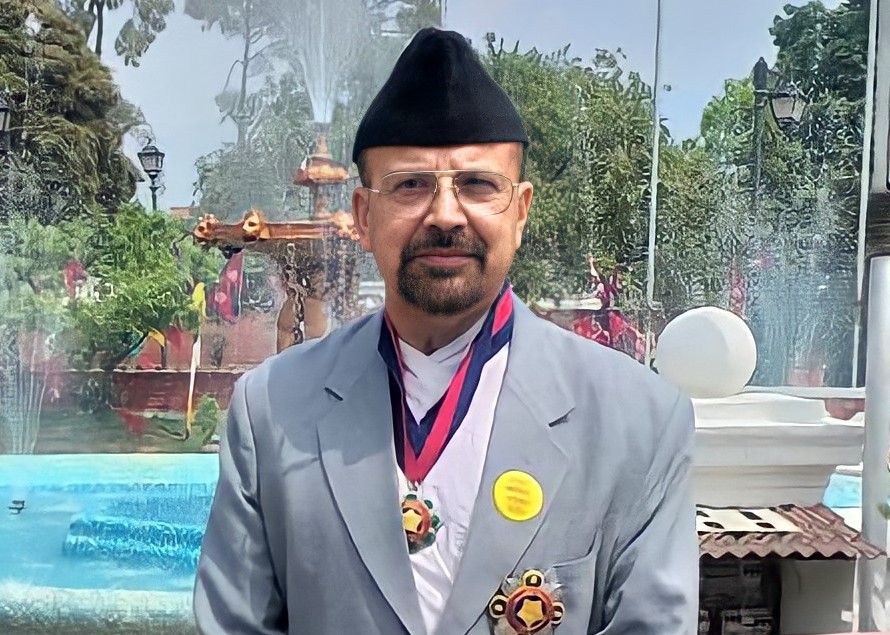
Local bodies are our major service providers as they are directly associated with the public and with broad work areas. They thus need more civil servants. But 55 percent of the allocated seats in local level civil services are vacant, creating a void between government and the public. The concerned authorities should immediately fill these vacant seats via federal and provincial Public Service Commissions. Prior to that, the parliament should pass the ‘Nijamati Ain’, which upholds the essence and importance of civil services.
The government must focus on recruiting professional technical staff, as their multiple skills will help get governmental work done in less time. It will also restore the credibility of the civil servants who are often accused of not doing their jobs on time. I believe in quality not quantity, so let’s not count posts but adjust them on a need basis. Our administrators have no idea of work division, but without it, we can’t be competent as well.
Dahal is an expert in public administration and former Secretary of the Nepal government
ApEx roundtable on problems of people with disabilities
Every disability is different. But all its variants hinder functionality, in one or the other way. While some disabilities might be visible, others that affect cognitive or learning abilities are called ‘invisible’. Nepal is still a long way from addressing the issues of persons with disability (PWD), mainly due to lack of coordination between different government agencies.
Representation is another issue that needs to be addressed. Although political parties have quotas for people with disabilities, discrimination against them continues: those getting the benefits are mostly the kith and kin of influential politicians. Though PWDs get identity cards, there is no census or a proper system for their documentation. Disability is still socially stigmatized, preventing parents and people in general from freely talking.
ApEx recently organized a roundtable on the topic with the objective of understanding the basics: the most common forms of disabilities in Nepal and the problems the sufferers face. Here are excerpts.
Rama Dhakal, Vice president, National Federation of the Disabled Nepal
Those like me with physical disabilities are at least visible and the media take up our issues to an extent, but those with invisible disabilities seldom get the needed exposure. Yet the biggest issue for all of us continues to be lack of inclusion in policy making. Political parties have ignored the essence of the constitution and misused PWD quotas by nominating their yes-men—those who don’t even consider themselves PWD. If people representing us can’t make it to the decision-making level, no one is going to advocate on our behalf and our issues will continue to be sidelined. Besides our mental, physical, and financial difficulties, lack of concern being shown by our political stakeholders is also a huge problem. This was also reflected in the recently concluded general conventions of major parties, where the issues of the PWD were completely sidelined.
Also read: ApEx roundtable: Mental health, youth and the pandemic
Devi Acharya, Chairman, Nepal Spinal Cord Injury Sports Association
A spinal cord injury (SCI) is a physical and visible injury, resulting in loss of functions such as mobility and feeling. Around 70 percent of SCI cases are the result of accidents at home like falling from trees or cliffs. A series of things should be done to stabilize an SCI victim, to be carried about step by step. That is an issue. There are hardly any professionals to assist disabled people in hospitals or disabled children in schools. Our hospitals lack even basic medical facilities for them. It takes hours or at times even days for a PWD to reach the hospital. Besides, we don’t have proper rehabilitation equipment, and the professional help needed to diagnose and treat SCI patients is inadequate as well.
Lakpa Norbu Sherpa, Chairman, Society of Deaf-blind Parents
Deaf-blindness is a combination of sight and hearing loss that affects a person’s ability to communicate, access information, and move around. Among different forms of disabilities, deaf-blindness is among the more severe one. My son has deaf-blindness and either my wife or me have to be with him all the time. People with this disability have no access to education, transport, and other daily needs. We, caretakers, are ignored by the government, and nor can we go outside our homes for advocacy. So we have been deprived of our shares of allowances and facilities.
I sometimes feel people with minor disabilities have suppressed our issues. Alongside, the concerned stakeholders have not been able to create an environment for an inclusive school where students with any disability can attend. If we could send our children to such schools, perhaps they could feel like other regular kids, which is also important for their sound mental health.
Also read: No political party for Nepalis with disabilities
Dr Sunita Maleku Amatya, Chairperson, Autismcare Nepal Society
My son has autism, which means he has difficulties in social interactions due to his repetitive patterns of thought and behaviors. This is referred to as a developmental disorder of variable severity. It is important to diagnose it early to cope with it the best possible way. In developed countries, the newborn are tested for the functionality of their organs and treated in case a disability is found. Unfortunately, our health service has no such mechanism for screening, delaying diagnosis. Problems are compounded by lack of further treatment and services, even though timely recognition and treatment could minimize the damages. Moreover, caretakers have a huge role in the life of PWD. Mental health of the caretakers should be prioritized and they should be recognized, appreciated and made more visible.
Shila Thapa, President, Down Syndrome Society of Nepal
Down syndrome is a condition in which a child is born with an extra copy of their 21st chromosome, resulting in physical and mental developmental delays and disabilities. But they can still live a healthy and fulfilling life. My son has this condition. What each stakeholder should know is people with Down can be valuable employees and are also ready to work, but often lack training and opportunity. The government has not done anything to help them be more independent. Nor has it financially supported the guardians of children with Down. The current government monthly allowances are peanuts. So the problems with all kinds of disabilities can be alleviated with due attention of policymakers as well as greater social awareness.
‘ApEx for climate’ Series | Money to adapt to climate change simply not there
At the United Nations, Nepal has presented an ambitious plan of achieving net-zero carbon emission by 2045. In addition, it has pledged before the international community that, come 2030, 15 percent of its total energy will come from clean sources and 45 percent of the country’s forest cover will be maintained.
These targets can only be achieved if the Nepal government secures sufficient funds for its adaptation and mitigation measures. That is why Nepal has made it clear that its climate commitments are contingent on funds from international organizations.
At the recent COP26 summit in Glasgow, Scotland, Prime Minister Sher Bahadur Deuba was clear that Nepal could deliver on its goals “only through quick, direct, and easy access to climate finance”. The country thus urged the international community to agree on a clear roadmap for a new collective, quantified and ambitious goal on climate finance before 2025.
After the finalization of the climate change budget code in 2012 in order to track allocations to climate change related projects and programs, the Nepal government has since 2013 set aside money under ‘climate change’ in its annual budget.
In addition, Nepal has been lobbying for funds from various bilateral and multilateral organizations to implement adaptation and mitigation measures and reportedly, it is already getting ‘millions of dollars’ even though exact figures are hard to come by. But there is a lack of transparency in the climate budget. Irrespective of the budgetary provisions, in the absence of dedicated mechanisms, it has been hard to track income and expenditure.
Also read: ‘ApEx for climate’ Series | Nepal makes its case. But to what effect?
There is a related problem as well. Even though both government and non-government agencies are implementing dozens of programs to address climate and environmental issues, it is difficult to isolate expenditure on climate issues in the absence of an exact definition of ‘climate expense’.
Says climate change watcher Manjeet Dhakal, money is being spent in specific areas of climate change but also on other indirectly linked areas. For instance, a few years ago, the government had allocated Rs 3 billion for the purchase of electric vehicles with the goal of reducing the emission of greenhouse gasses, says Dhakal.According to him, even though the Ministry of Forest and Environment is the focal ministry, other government agencies are also allocating budgets on climate-related issues. Compared to the past, there is greater awareness on climate change in government agencies, and thus also on the need to allocate budget for it. In addition, government agencies are starting to adopt sustainable development models.
But current budgetary allocations are not sufficient to achieve net-zero by 2045, which the government aims to do by increasing the use of renewable energy.
Nepal submitted its second Nationally Determined Contribution (NDC) to the United Nations under the Paris Agreement. In the NDC, Nepal has committed to a slew of measures to reduce carbon emissions and launch adaptation and mitigation actions. An estimated $25 billion is required to meet the targets—and hence the conditional clause in the NDC.
Also read: ‘ApEx for climate’ Series | Nepal in the middle of a climate crisis
To get support, the Fifteenth Plan (2019-2024) talks about ‘advocating at the international level for easy access to climate finance and distributing any potential benefits to provincial, local, and community levels.’
Similarly, the Climate Change Policy introduced in 2019 states that “national resources will be identified for the implementation of climate change-related policies, and all resources will be mobilized in a just manner by increasing access to bilateral, multilateral, and international financial resources pertaining thereto.”
Climate finance involves many actors and agencies like government bodies, development partners, UN agencies, multilateral development banks, I/NGOs, local institutions, corporate houses, and user groups.
Specifically, Nepal can get financial support from multilateral international financial mechanisms such as REDD+, Green Climate Fund, Global Environment Facility, Adaptation Fund, Climate Investment Fund, and Carbon Trade. Similarly, it can and has been getting funds through various bilateral mechanisms in sectors like agriculture and forest.
“The private sector actors for their part can invest in climate via initiatives under their corporate social responsibility,” says Dhakal.
Also read: ‘ApEx for climate’ Series | How does Nepal get help in tackling climate change?
But at the end of the day Nepal and other LDCs will have sufficient money for climate action only if developed countries fulfill their commitments. In the Copenhagen Accord signed in 2009, developed countries pledged approximately $100 billion by 2020, which was not delivered. The Paris Agreement 2015 reaffirmed the commitment, but also to no avail.The Paris Accord says, “As part of a global effort, developed country Parties should continue to take the lead in mobilizing climate finance from a wide variety of sources, instruments, and channels, noting the significant role of public funds, through a variety of actions, including supporting country-driven strategies and taking into account the needs and priorities of developing country Parties. Such mobilization of climate finance should represent a progression beyond previous efforts.”
At COP26, developed countries again pledged to meet the old target by 2023.
Nepal’s own budgetary allocation for climate has been steadily increasing, and today all three levels of government have yearly climate budgets.
There is also a question over how the three tiers of government are spending their climate funds. The country’s climate change policy provisions for mobilization of 80 percent budget for local-level climate programs by reducing administrative expenses. The policy also states that there will be appropriation of the budget for women, minorities, backward class, climate change affected areas and vulnerable communities.
Yet a large portion of the climate budget, say the critics of the current arrangement, is being spent on meetings and seminars in Kathmandu rather than on the ground. “For our climate initiatives to be effective, around 80 percent of the climate budget should be spent at the local level,” says climate journalist Mukesh Pokhrel. “But a far smaller share goes to local bodies right now.”
Also read: ‘ApEx for climate’ Series | Putting Nepal’s gen-next in climate lead
The federal government in Nepal appropriates 60 percent of the total budget while local governments get only 20 percent. The provincial governments, for their part, get 12 percent.Nepal has pledged with the international community to formulate climate finance strategy and national capacity on climate finance management by 2022. Homework on this has begun but progress has been patchy. Till date, there is no mechanism in Nepal to exclusively handle climate finance. There is a separate ‘climate change’ division under the Ministry of Forest and Environment but experts say a separate body is needed to coordinate with other government agencies.
In recent years, the government has launched some specific programs targeting climate change. In 2021/22, the Nepal government launched a carbon emissions reduction program in 13 districts of Tarai Madhes including Rautahat, Bara, Parsa, Chitwan, Banke, Bardiya, Kailali, and Kanchanpur.
In the fiscal year 2020/2021, it started research programs on forest, plant resources, wildlife, biodiversity, watershed, environment, and climate change in coordination and partnership with universities and research institutions.
More than that, there is a need to decentralize the climate budget and take it to the grassroots where the most adverse effects of climate change are felt. At the same time, local governments should be empowered to deal with climate change issues. “But most of the money is being spent in administrative and non-productive areas. There should be a thorough review of what we are doing,” advises Pokhrel.
Nepal’s priorities don’t match the donors’
Ram Chandra Bhattarai, Economist
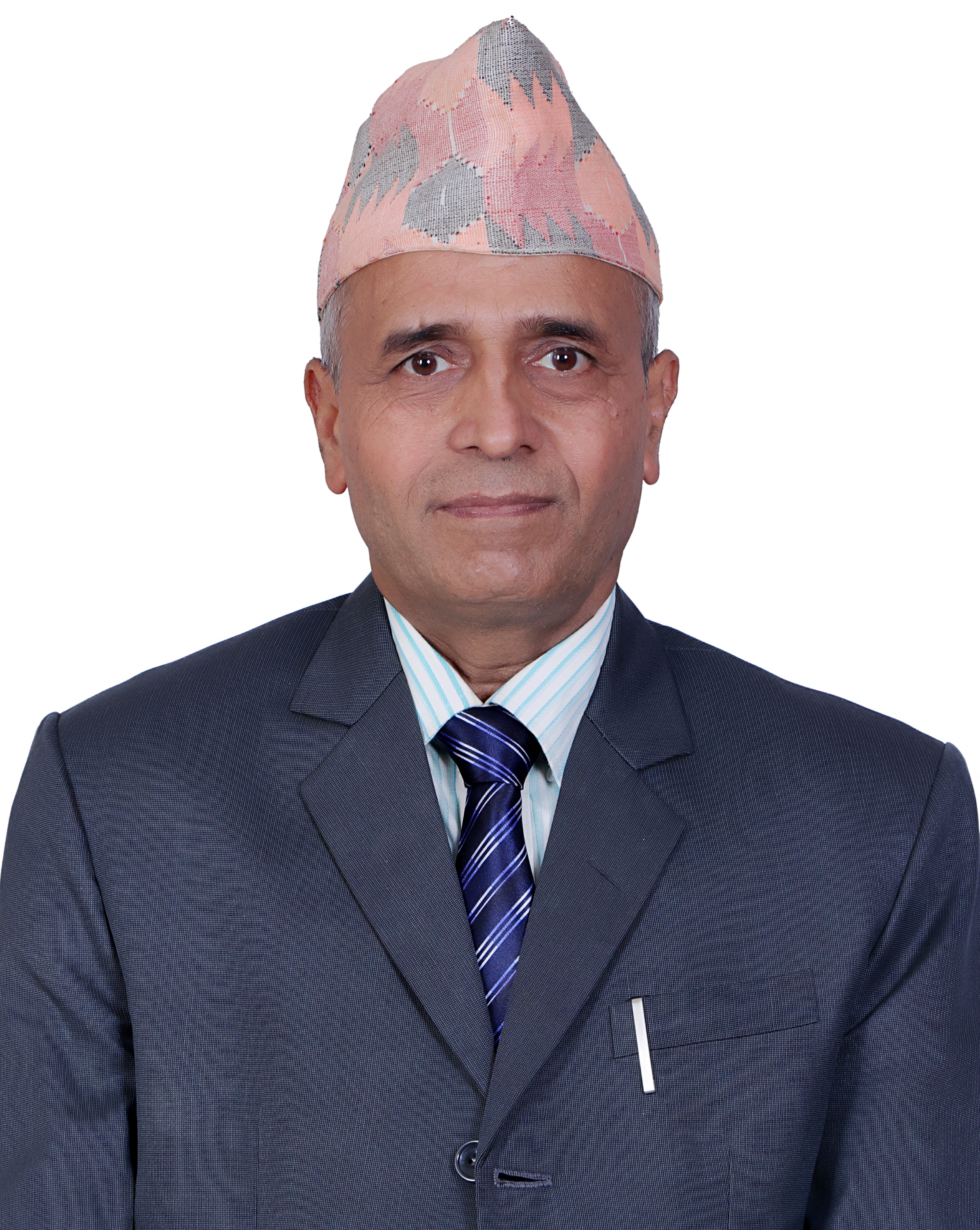
We are spending less than three percent of our Gross Domestic Product (GDP) in the climate sector. Climate finance is basically what donors give us. It is donor-guided and as such their interests prevail. We basically need finance for our adaptation measures.
We are more responsible for adaptation than mitigation. Nepal does not contribute to climate change but faces most of the related problems. Yet there is little international support on adaptation. We are doing adaptation mostly on our own; most of the help we get from abroad goes into mitigation, which is the donors’ interest.
Donors are investing in alternative energy but that is not our number one priority right now. They are not providing pure climate finance—just transferring money already allocated to other sectors.
We are making a lot of noise on climate change and climate finance but there has been little progress. Even our usual expenditure has been clubbed under ‘climate change initiatives’. For example, the money we are spending on the preservation of our forests. When it comes to actual spending on climate change, there is little of it.
Five questions to Manjeet Dhakal
Achieving net-zero emission is not difficult for Nepal
Though Nepal is recognized as one of the most vulnerable countries to climate change, there is little in terms of preparation for a possible climate crisis, or in mitigation measures. How can we be better prepared? And do we have the money and other resources to pursue climate initiatives? Pratik Ghimire of ApEx talked to Manjeet Dhakal, a student of climate change who is also the Head of the LDC Support Team at Climate Analytics.
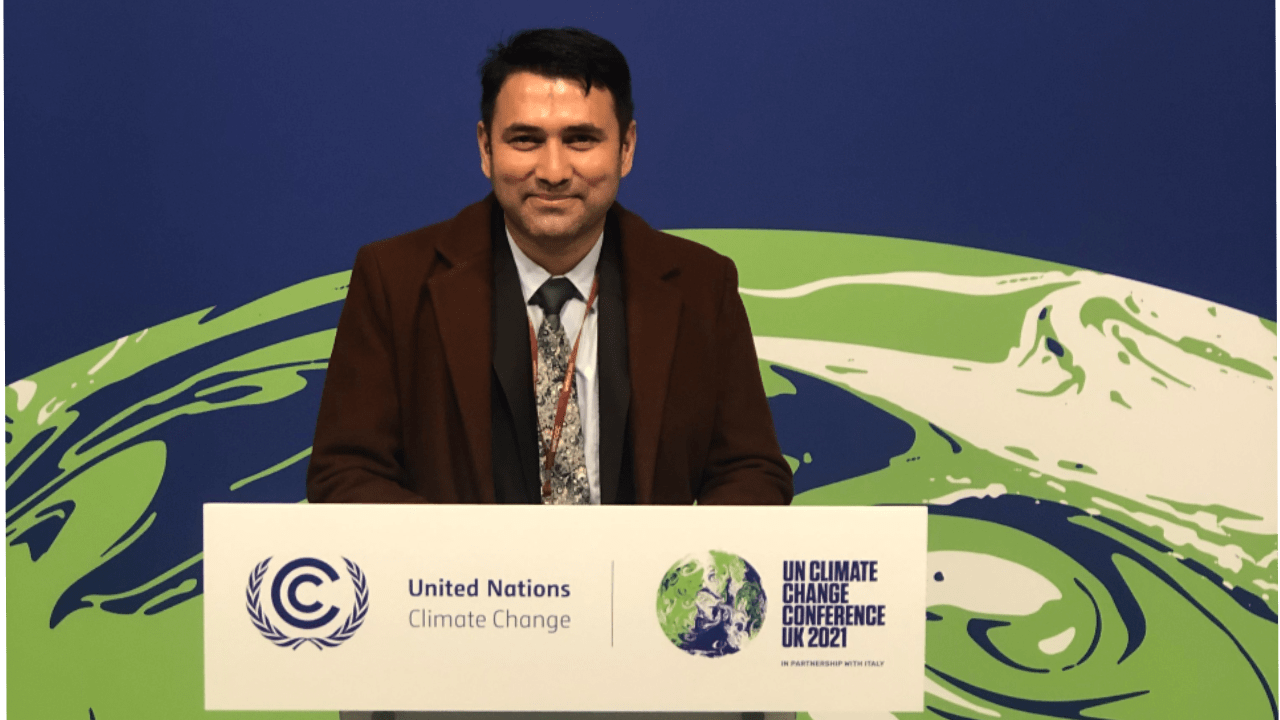
What is the current status of the effects of climate change in Nepal?
Many reports have suggested that Nepal is highly vulnerable to climate change. This is also because temperatures here are increasing faster compared to other parts of the world. Erratic rainfall has destroyed our crops, leading to an agro-based job crisis. Moreover, climate change has caused floods and other disasters, and destroyed vital infrastructures like the Melamchi Water Project. This has put added strain on our already stretched economy. Effects of climate change also depend on a country’s economic status. Well-off countries can take up measures to build resilience. As we can’t afford that we are forced to bear the brunt of climate change.
Can Nepal achieve net-zero emissions by 2045 as promised at COP26?
I don’t think it is going to be difficult as there has been a massive development in climate technologies. We now can, for instance, switch to electric vehicles instead of petrol and diesel ones. That would substantially reduce carbon emissions. As Nepal has only a handful of industrial sites, we can easily electrify the new factories. The government is aiming to increase forest cover to 45 percent of the land by 2030. Hopefully, the goal can be achieved. Nepal imports around Rs 200 billion worth of petroleum products a year. We can channel that money in the development of electric machinery instead.
How do you see Nepal’s climate diplomacy?
I find it progressive and reform-oriented as we are frequently invited to climate change-related international summits and given the chance to share our data and situation. That said, it is not easy for a small nation to maintain diplomatic relations, especially on climate issues, given our limited resources.
Also read: Bishal Nath Upreti: There is no quick fix to Kathmandu’s flooding
Is the international community turning a blind eye to our mountain agenda?
I don’t think so. If you go back to the recent COP26 summit, Prime Minister Sher Bahadur Deuba presented our agenda and the international community responded positively. There are some failed projects too. But we have to look at our mistakes first. They had shown an interest in Sagarmatha Sambad as well, but we couldn’t push it. The best thing that happened at COP26 is that we didn’t ask for help, we rather shared our initiation and progress. Prime Minister Deuba has committed to organizing Sagarmatha Sambad and let’s hope he means it.
Moreover, it is technically difficult to extract data from mountain regions, which might have been looked upon as ignorance. But it is the same for other nations who raise mountain agendas. We get a good response otherwise.
How can Nepal get enough climate finance for adaptation and mitigation?
We have to find international funding for that, and to an extent, we are getting that too. No nation provides funds easily, so we have to convince them with our vulnerability reports, data, commitments, obligations, and authentic process and progress. A decade ago, developed nations had pledged $100 billion annually to the least developed nations to fight the climate crisis. But the pledge has not been met. Yet, compared to others, we are among the countries that get good international funding on climate issues.
We can also do our bit by reducing the import of petroleum products and using the saved money as climate finance. By doing that, first, we will greatly reduce our trade deficit, and second, greater use of electric machinery will also help us clean up our environment. Separately, if we can cut down the import of petroleum products by only five percent, we can provide Covid-19 vaccines to every Nepali.
Nepali political parties far from inclusive
In line with the inclusive principles enshrined in the Constitution of Nepal 2015, the three major political parties—in their recently held general conventions—included cluster-wise inclusion in their central committees (CCs). Yet while the inclusive principles were applied in selection of lower-level leaders, top positions continued to be in the hands of the traditional elite groups.
In its eighth general convention, CPN (Maoist Center) Chairman Pushpa Kamal Dahal ‘Prachanda’ admitted that inclusion compulsions had prolonged the party’s central committee selection. “Our inclusion system has drawbacks, and it has mostly to do with our policies,” he said before announcing the new central committee. Dahal claimed the party didn’t find a single Muslim woman to be inducted in the CC. The party, however, has tried to include more youths as each gender-ethnicity group has a youth component.
Other political parties have a similar story. CPN-UML has its new cluster named ‘[Kathmandu] valley special’ yet two of the members elected in it were from outside the Kathmandu Valley. The party doesn’t have a single person living with disability in its CC. Nor do any of the major parties have members representing the LGBTIQA+ community.
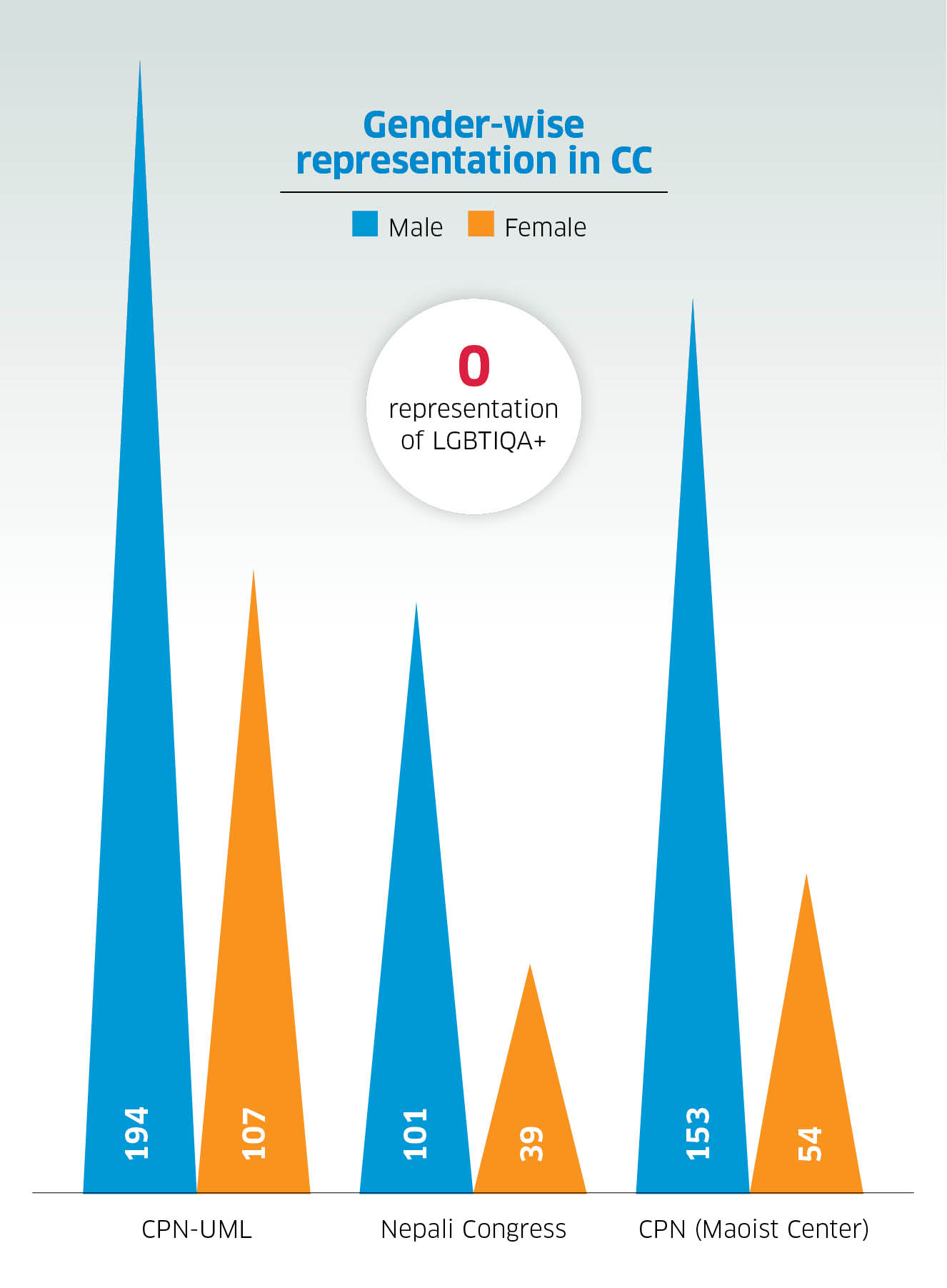
Unlike the Maoist and the UML, the Nepali Congress held elections for the party’s Central Working Committee and the candidacies contending for leadership were in consonance with the clusters. But the inclusion of privileged candidates like Arzu Deuba from the women’s quota, Binod Chaudhary from the Madhesi quota, and Umesh Shrestha from Janajati quota came to be widely criticized.
The conventions also brought many political couples to the respective central committees, which was essentially a triumph of nepotism over inclusion. Reservations and quotas are clearly meant to lift the marginalized groups, not for the elevation of the already dominant groups.
According to the constitution, women are marginalized on a gender basis, Madhesis and Janajatis on a cultural basis, Dalit on a caste basis, and remote areas on a geographical basis, and inclusion should be made proportional to their respective population shares. Therefore, UML should have had at least 100 Janajati members in the CC, as Janajati are 36 percent of Nepal’s population—but that is not the case. All the major parties are led by Khas-Arya males who seem to see inclusion as a danger to their traditional hold over power.
Political elites continue to be exclusionary
Tula Narayan Shah
Political analyst
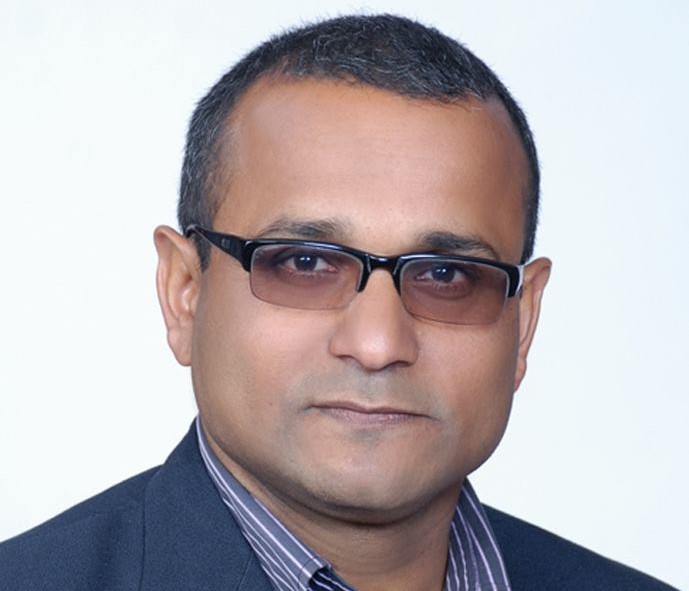
Even after various political movements in Nepal that championed the agenda of inclusion, things have not changed much. During the Panchayat period, Chhetris used to be political party leaders and Brahmins their advisors, now Brahmins are the leaders with Chhetris are right behind them. The tendency is not to recognize leaders from the marginalized groups as national leaders.
Nepal adopted the inclusion policy by relying on the Interim Constitution 2007, which provided for reservation in the bureaucracy, increased electoral constituencies and revised the election process. Yet the state is yet to take ownership of these agenda. Unless the elite class becomes more accommodative, change is difficult, as demonstrated by the recent party conventions. What happened was, basically, those in power used inclusion principles to cement their own hold.








